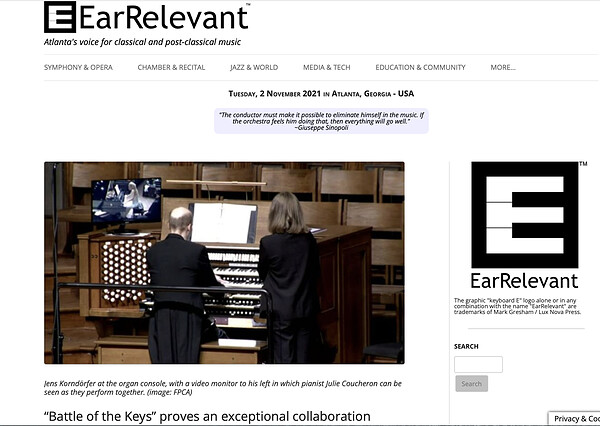Review
“Battle of the Keys” proves an exceptional collaboration

On Friday, October 29th, in the First Presbyterian Church of Atlanta, pianist Julie Coucheron and organist Jens Korndörfer “crossed swords” — sorry, better to say “keyboards” — in an epic battle, which had nothing of a struggle but all charisma of an exceptional musical event. Even if not new, the idea was certainly a winning one, especially with two musicians of this caliber.
Their choice of armaments: the first movement of the Emperor concerto by Beethoven, two movements of an organ symphony by the French composer Charles Marie Widor, two Lyric Pieces from Op. 43 of Edward Grieg, and a world premiere piece by the British composer and organist David Briggs.
So far, the forces in the field seemed to be well balanced, and equal opportunity was given to each participant.
Ludwig van Beethoven wrote his fifth and last piano concerto, Op. 73 in 1808-09. Because of his then total deafness, he was unable to perform the solo part himself, and the honor fell to the young Friederich Schneider. This remains the most popular of the five piano concertos.
Julie Coucheron played the first movement (“Allegro”) with the orchestra part delivered by the organ.
Now, should somebody have said to me before if such a thing is possible, I would have denied it. Piano and organ? Together? No way!
But what Mr. Korndörfer delivered from the beginning was quite a show.
His hands and feet seemed to be everywhere at once. The changes of keyboards and presets went on at a breathtaking speed, certainly with a big help from his anonymous page turner and registrant, who delivered an incredible job, too. To say it frankly, after a while the orchestra was no longer missed.
Ms. Coucheron played the solo part with her usual technical capacity...
Charles-Marie Jean Albert Widor (1844-1937) was a French organist and a prolific composer. Today known mainly for his organ works, he wrote many solos, chamber music, and even operas — much apparently forgotten. That’s a pity, as his music is well written, has its personal charm, and would need rediscovery like so many pieces from this period.
Jens Korndörfer has chosen the last two movements, “Cantabile” and “Finale,” from the Organ Symphony No. 6 in G minor Op. 42 No. 2.
This was a winning choice as this Romantic organ music seemed perfect for the instrument at his command. The result was an absolute orgy of complicated movements, brilliant pedal technique, and a well-selected array of registration choices.
Julie Coucheron answered this with two of Edward Grieg’s Lyric Pieces, Op. 43, entitled “Butterfly” and “To spring,” or if you prefer, in the original Norwegian: “Sommerfugl” and “Til våren.” Both, composed probably in 1886, are dedicated to the German pianist and composer Isidor Seiss.
This Nordic world is clearly near to the sensibility of Ms. Coucheron, so the performance was, as expected, wonderful.
The final and decisive battle occurred on common ground: the premiere of a piano and organ piece from the British composer David Briggs (1962-) called Poème rhapsodique. First Presbyterian Church of Atlanta, where this concert took place, commissioned this work.
There are many things every composition student learns to avoid, like combining piano and harp, or as in this case, piano and organ.
Mr. Briggs, who was present personally and thanked the public after the concerto’s end, was asked to do precisely this, and he was very, very successful. Even with all the imaginable difficulties of a piano to be an equal partner to a big church organ, his composition was a masterful combination of colors, rhythmical subtlety, and refined harmonics.
The rendering of both artists was at its maximum and near perfection.
I could easily imagine that such a combination of instruments could find many composers willing to write for it.
So who was the winner of this battle? An easy guess. When such great talents are performing, there is only one winner: the music!